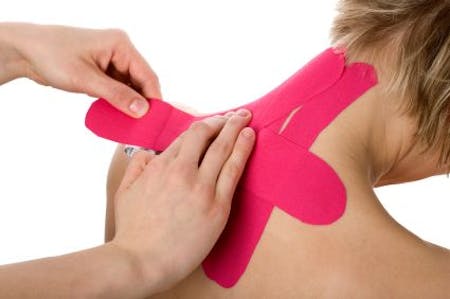
Kinesio taping is a method used to help normalize the function of muscles and other connective tissues. We may use taping as a part of your therapy, and also offer tape for your ongoing use at home.
Kineso taping uses elastic tape rather than the rigid tape traditionally used in sports. The elastic properties of this tape help in many ways:
- Improve contraction of a weakened muscle
- Reduce muscle fatigue and spasm
- Reduce over-stretching and over-contraction of muscles
- Re-educate muscles through sensory feedback
- Lessen edema (swelling) through aiding the lymphatic system
- Minimize post-traumatic or post-surgical bruising through improved circulation
- Help mobilize scar tissue by enhancing glide between tissue layers
- Help correct joint mechanics through aiding muscle function around the joint
- Relieve pain by activating the natural analgesic system in our skin receptors
As a part of physical therapy, Kinesio taping is best used as an adjunct to therapy and exercise. It can dramatically speed the rehabilitation process by lessening pain and improving tolerance to exercise and movement. The success of Kinesio taping strongly depends on clinician knowledge. A thorough evaluation is integral to determine which taping techniques are indicated. For instance, the clinician must know if the patient needs taping to assist muscle strengthening or to assist muscle relaxation, as the taping will be different. A good physical therapy program goes hand-in-hand with good taping.
Kinesio Taping: What is it? Dr. Kenzo Kase nearly 20 years ago developed this taping technique for the Sports Medicine and Rehabilitation Clinics in Japan. Since this introduction of Kinesio Taping into the U.S., medical practitioners have recognized and embraced this effective, safe, and easy-to-use modality. The method and tape allow the individual to wear and receive the therapeutic benefits on a 24-hours/day basis and can be worn for several days per application. Currently, Kinesio Taping is practiced in clinics, high schools, and by professional sports teams.
The Kinesio Taping Method involves taping over and around muscles in order to either: assist and give muscle support, or to prevent over contraction of the muscles. The first technique gives the practitioner the opportunity to actually give support with a full range of motion that enables the individual to participate in physical activity with functional assistance. The second technique helps fight against overuse/contraction and helps provide 24 hours/day facilitation of lymphatic fluid. This technique is most commonly used in the acute stage of rehabilitation. Lastly, there are many types of correctional techniques such as: myofascial, lymph, and tracking (i.e., patella [knee cap]) Kinesio Tape can be best used in conjunction with Physical Therapy treatments.
How does this work? Kinesio Taping alleviates pain and facilitates lymphatic drainage by lifting the skin. The taped portion forms convolutions in the skin thus increasing interstitial space. The result is that pressure and irritation are taken off the neural/sensory receptors. Slowly pressure is taken off the lymphatic system allowing it to drain more freely.
Kinesio Taping is a technique based on the body’s own natural healing process. This Kinesio Taping exhibits its efficacy through the activation of neurological and circulatory systems. This method basically stems from the science of Kinesiology, hence the name “Kinesio”. Muscles are not only attributed to the movements of the body but also control the circulation of venous and lymph flows, body temperature, etc. Therefore, the failure of the muscles to function properly induces various kinds of symptoms.
Consequently, so much attention was given to the importance of muscle function that the idea of treating the muscles in order to activate the body’s own healing process came about. Using an elastic tape, it was discovered that muscles and other tissues could be helped by outside assistance. Employment of Kinesio Taping creates a totally new approach to treating nerves, muscles, and organs. The first application of Kinesio Taping was for a patient with articular disorders. Kinesio Tape is used for anything from headaches to foot problems and everything in between.
Examples include: muscular facilitation or inhibition in pediatric patients, carpal tunnel syndrome, lower back strain/pain (subluxations, herniated disc), knee conditions, shoulder conditions, hamstring, groin injury, rotator cuff injury, whiplash, tennis elbow, plantar fasciitis, patella tracking, pre and post-surgical edema, ankle sprains, athletic preventative injury method, and as a support method.
Kinesio tape facilitates normal motion, decreases edema, improves pain and facilitates biomechanical alignment. Elastic tape is water-resistant, durable and easy to wear, usually 3-5 days, latex-free and generally very well tolerated.
Elastic taping is not just for athletes. We utilize this intervention for support and pain relief for post-operative conditions, acute injury, back pain, during pregnancy, with children and adolescents, scoliosis, for postural support, sacroiliac (SI) dysfunction and many other conditions. It is an adjunct to our manual therapy, neuromuscular re-education, therapeutic exercise and modalities to return people to pain-free living without surgery or medication.

